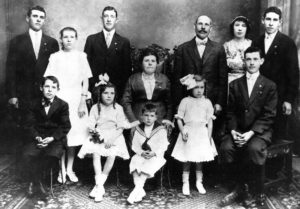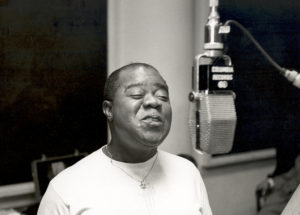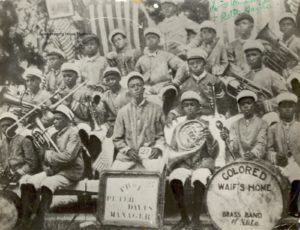The often-told story of Louis Armstrong’s early life has passed into American legend, an early twentieth century Horatio Alger-styled tale of an impoverished black child who rises from the humblest of beginnings to fame and fortune through hard work, courage, and talent.
Armstrong spent his entire life believing that he was a “Yankee-Doodle Dandy”, born on the fourth of July in 1900. However, it was in the mid-1980s that the music historian Thaddeus Jones (1952-2007), in researching Louis Armstrong’s early life, discovered baptismal records that definitively established Armstrong’s date of birth as August 4, 1901.

There has never been any question about the location of Armstrong’s birth: New Orleans. He was born out of wedlock to Mary (“Mayann”) Albert (1885-1927) and William Armstrong (1880-1933). William abandoned the family soon after Louis’ birth, though he reappeared long enough to once again impregnate Mayann, who gave birth to a second child two years later. (Named Beatrice, she went by the fabulous nickname of “Mama Lucy”.)
With his father’s departure, the infant Louis was initially raised by his paternal grandmother; his mother Maryann, who worked as a domestic and as a prostitute, came and went. When the young dude was about five he was reunited with his mother and sister (and a long line of so-called “step-fathers”) in a derelict shack on Perdido Street in the worst neighborhood in New Orleans, called “The Battleground”. From there, according to the New Grove Dictionary of Music and Musicians, “he attended Fisk School nearby, ‘wailed’ enthusiastically at the sanctified Baptist church across the street, ‘second-lined’ marching brass bands, and absorbed the proto-jazz mixture of ragtime and blues pouring from surrounding honky-tonks, brothels, and saloons.”

At the age of six Louis got the first big break of his young life. He went to work for a junk dealer named Morris Karnoffsky. The Karnoffsky family took a shine to the child. Knowing his domestic situation, they took him in: they fed him, supported him, and ended up treating him like a member of the family. It was Morris Karnoffsky who fronted Armstrong the money to buy his first cornet when he was eleven years old. Writing in his memoir Louis Armstrong + the Jewish Family in New Orleans, La., the Year of 1907, Armstrong observed that:
“I had a long time admiration for the Jewish people. Especially with their long time of courage, taking so much abuse for so long. I was only seven years old, but I could easily see the ungodly treatment that the white folks were handing the Jewish family whom I worked for.”

In honor of the Karnoffsky’s, Armstrong wore a Star of David around his neck for the rest of his life. (When asked about his religion Armstrong would answer that he was raised a Baptist, wore a Star of David, and was friends with the Pope!)
Armstrong got his second big break on December 31, 1912, when he was arrested for shooting a gun into the air (blanks, as it turned out) in celebration of the New Year. (This was a break? You bet; keep reading!) He was shipped off to New Orleans’ Colored Waif’s Home, run with Spartan military discipline by one “Captain Joseph Jones.” Captain Jones believed in the moral and disciplinary merits of music, and hired a local musician named Peter Davis to run the home’s band. Davis became Armstrong’s first cornet teacher, and his progress was so rapid that Davis soon appointed him bandleader. (Getting arrested turned out to be, for young Louis, a major break, yes? Yes!)

There’s lots more to tell, but from here the story of Armstrong’s musical career marks a continuous upwards trajectory and sort of tells itself. Released from the Waif’s Home at 13, Armstrong never returned to school; rather played, and played, and played. First in dance halls, then on riverboats, all the while improving and playing in better and better bands. The musicians he worked with became his teachers: he learned to read and write music, to sight-read and to arrange. In 1922, Armstrong moved to Chicago in order to join the renowned “King” Oliver band, with which he made his first recordings in 1923. In 1924 it was off to New York City, where Armstrong joined what was then the top Black-American band, the Fletcher Henderson Orchestra. It was there – with the Henderson outfit – that Armstrong lay down his beloved cornet and switched to the trumpet, in order to better blend in with his section.

By 1925 Armstrong was ready to go out on his own. He returned to Chicago and organized his own band, calling it “Louis Armstrong and his Hot Five.” The Hot Five cut their first records in Chicago on November 12, 1925. From that moment until his dying day on July 6, 1971, Louis Armstrong never recorded under anyone else’s name but his own. … continue reading, and see Dr. Bob’s Prescribed recordings, only on Patreon!
